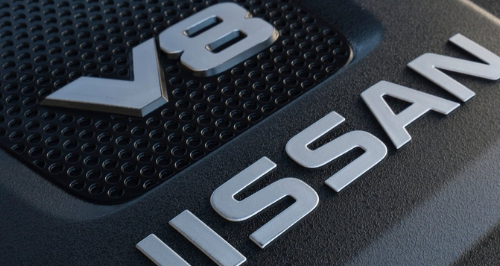Make / Model Search
Future models - Nissan - PatrolNissan set to axe V8 Patrol: reportNext-gen Patrol may offer GT-R twin-turbo V6 power, but still no diesel10 Feb 2022 NISSAN looks set to scrap its petrol V8-powered Patrol as early as next year. A new report suggests the Japanese marque will install a twin-turbocharged V6 in ‘Y63’ models when the seventh generation of the Japanese firm’s upper large SUV makes its debut.
According to a United States based dealer, an internal briefing on the upcoming Armada – the nameplate under which the Patrol is sold in North America – detailed a more efficient twin-turbo V6 in place of the long-serving VK56VD-series naturally aspirated 5.6-litre V8.
If true, the news means the full-size, but low-volume, Titan pick-up will be the only Nissan model to continue with the direct-injected and all-alloy V8 mill.
“Fuel efficiency is on everybody’s mind,” a Nissan dealer told Automotive News. “If they (Nissan) can get the same horsepower and torque out of a V6, why not?”
Australian Patrols feature petrol V8 power exclusively. Nissan deleted the turbo-diesel engine from its range when the Y61-series Patrol was retired in 2016. At this stage, there appears to be no plans to reintroduce an oil-burning engine into the next-generation Patrol range.
The current seven-seat Patrol wagon – which was recently updated for 2022 model year – has been powered by Nissan’s 298kW/560Nm V8 since the model was introduced a decade ago. It has subsequently struggled to match the sales volume of its long-serving Toyota rival.
To the end of January (2022), Nissan sold just 115 examples of the Patrol in Australia compared with Toyota’s tally of 730 LandCruiser wagons.
While it is unclear as to exactly what engine will replace the Patrol’s V8, it is understood that the now 14-year-old 3.8-litre VR30DDTT-series V6 – itself an evolution of the VQ-series V6, which dates to 1994 – may be pressed into service.
The engine, which currently serves in the Nissan Z and Infiniti Q50 and Q60 models, also powers the current Nissan GT-R in VR38DETT guise. In that application, the unit offers up to 529kW of power and 780Nm of torque – a significant uptick over the Patrol’s current specifications.
And while the possibility of a ball-tearing GT-R V6 in the Patrol are slim, it is conceivable that a high output V6 with some form of electric hybridisation may eventuate.
If the US-based report is to be believed, Nissan will soon join a raft of manufacturers in abandoning V8 power. As well as Toyota (LandCruiser 300 Series, Sequoia, etc.), Ford now also offers turbocharged V6 power in its Expedition, while Jeep will soon offer a turbocharged six-cylinder in its similarly sized Wagoneer.
The Renault-Nissan-Mitsubishi Alliance recently announced that it was moving away from thermal engines globally as consumer focus shifted towards electrification, although large vehicles such as the Patrol were notably absent from the company’s “2030 roadmap”.
Just 18 months after announcing its new co-operation business model, Renault Group, Nissan Motor Company Limited and Mitsubishi Motors Corporation unveiled a set of common projects that the trio says will accelerate and shape its shared future towards the end of the decade.
The roadmap focuses heavily on the mobility value chain, pure electric (BEV) vehicles and connected mobility. The group says it will expand the use of common platforms to 80 per cent by 2026 while, at the same time, increasing its research into solid-state battery technology.
The Alliance partners say they plan to invest €23 billion ($A36.6 billion) over the next five years in support of its electrification programme.  All future models Alfa Romeo Alfa Romeo Abarth Abarth Alpine Alpine Alpina Alpina Audi Audi Aston Martin Aston Martin BMW BMW Bentley Bentley Chery Chery Brabham Brabham Chrysler Chrysler Chevrolet Chevrolet Cupra Cupra Citroen Citroen DS DS Dodge Dodge Fiat Fiat Ferrari Ferrari Foton Foton Ford Ford Great Wall Great Wall FPV FPV Haval Haval GWM GWM Honda Honda Holden Holden Hummer Hummer HSV HSV Infiniti Infiniti Hyundai Hyundai Jaguar Jaguar Isuzu Isuzu Kia Kia Jeep Jeep Land Rover Land Rover Lamborghini Lamborghini Lexus Lexus LDV LDV Mahindra Mahindra Lotus Lotus Mazda Mazda Maserati Maserati Mercedes-AMG Mercedes-AMG McLaren McLaren MG MG Mercedes-Benz Mercedes-Benz Mitsubishi Mitsubishi Mini Mini Opel Opel Nissan Nissan Peugeot Peugeot Pagani Pagani Proton Proton Porsche Porsche Renault Renault Ram Ram Rover Rover Rolls-Royce Rolls-Royce Skoda Skoda Saab Saab SsangYong SsangYong Smart Smart Suzuki Suzuki Subaru Subaru Toyota Toyota Tesla Tesla Volvo VolvoPatrol pricing
Motor industry news |
Click to shareNissan modelsResearch Nissan All future models Alfa Romeo Alfa Romeo Abarth Abarth Alpine Alpine Alpina Alpina Audi Audi Aston Martin Aston Martin BMW BMW Bentley Bentley Chery Chery Brabham Brabham Chrysler Chrysler Chevrolet Chevrolet Cupra Cupra Citroen Citroen DS DS Dodge Dodge Fiat Fiat Ferrari Ferrari Foton Foton Ford Ford Great Wall Great Wall FPV FPV Haval Haval GWM GWM Honda Honda Holden Holden Hummer Hummer HSV HSV Infiniti Infiniti Hyundai Hyundai Jaguar Jaguar Isuzu Isuzu Kia Kia Jeep Jeep Land Rover Land Rover Lamborghini Lamborghini Lexus Lexus LDV LDV Mahindra Mahindra Lotus Lotus Mazda Mazda Maserati Maserati Mercedes-AMG Mercedes-AMG McLaren McLaren MG MG Mercedes-Benz Mercedes-Benz Mitsubishi Mitsubishi Mini Mini Opel Opel Nissan Nissan Peugeot Peugeot Pagani Pagani Proton Proton Porsche Porsche Renault Renault Ram Ram Rover Rover Rolls-Royce Rolls-Royce Skoda Skoda Saab Saab SsangYong SsangYong Smart Smart Suzuki Suzuki Subaru Subaru Toyota Toyota Tesla Tesla Volvo VolvoPatrol pricing
Motor industry news |









Facebook Twitter Instagram